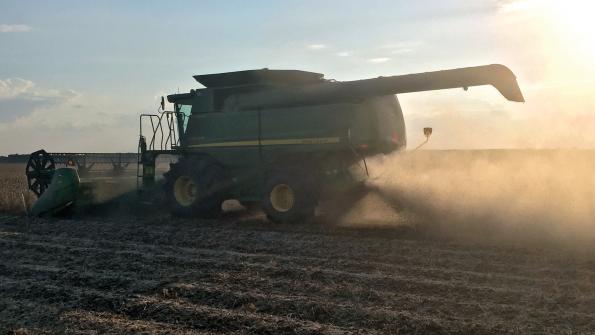November 3, 2016

A game-changing insect caused significant problems in many Mississippi soybean acres, but good management allowed growers to finish the year with an average crop.
The U.S. Department of Agriculture estimated that by Oct. 23, Mississippi farmers were 92 percent finished harvesting the state’s soybean crop, which covered about 2.03 million acres this year. Insect and disease pressures made the effort challenging, but USDA predicts growers will harvest a state average of 48 bushels an acre.
Angus Catchot, an entomologist with the Mississippi State University Extension Service, said redbanded stink bugs showed up in large numbers in many fields late in the season.
“The most affected acres were the later planted soybeans south of Highway 82 across the state,” Catchot said. “They were as much of a problem in the hills as in the Delta.”
Although south Louisiana deals with these insect pests every year, Mississippi growers have rarely dealt with them since 2009.
“They’re very aggressive feeders, doing much more damage than our traditional stink bugs, which are the Southern green stink bug, the green stink bug and the brown stink bug,” he said. “A lot of the time, they move into fields in really high numbers much later in the season, often when we’re done scouting for insects. It caught a few people off guard because we don’t deal with it regularly.”
MSU researchers make threshold recommendations to guide growers in determining when they should treat fields for certain pests.
“Going into 2017, we’re changing our thresholds for this pest,” Catchot said. “The threshold has been six redbanded stink bugs per 25 sweeps, rather than nine per 25 sweeps for our traditional stink bugs. In 2017, that threshold is going to change to four per 25 sweeps.”
These pests are sensitive to cold winters, so a moderate season would allow many to overwinter in the state. In addition, although they can be controlled by pesticides, there are fewer options to use against this insect.
“We’re going to have to pay very close attention to them going forward, from a management and control perspective,” Catchot said.
Despite the challenges, Extension soybean specialist Trent Irby said Mississippi growers are in position to harvest a respectable crop. Forecasted yields are not far below the record 52 bushels an acre harvested in 2014.
“We had some really good acres this year and some acres that didn’t turn out as well as we had expected due to late-season disease and insect issues,” Irby said. “Overall, our crop this year will be right at the five-year average.”
In addition to insects, many growers dealt with crop disease, particularly target spot, to which some soybean varieties appeared to have poor resistance. Much of the state had rain for three weeks straight in August, which created ideal environmental conditions for diseases to thrive.
Delta Farm Press Daily
Stay current on what’s happening in Mid-South agriculture: Subscribe to Delta Farm Press Daily.
Growers were able to manage these challenges, but price is out of their control.
Brian Williams, an Extension agricultural economist, said soybean prices have been on a slow downward slide since July, but they are better than they were a year ago.
“Prices have leveled off some since the first part of September, and we have actually seen some slight positive movement over the last two weeks,” Williams said.
Greenville cash prices are $9.72 per bushel as of late October, compared with $9.26 a year ago. November soybean futures are trading for $10.05 a bushel, much higher than last year’s $8.99.
“The overall decline that we have seen since July has been driven primarily by excellent crop conditions and the expectations of a record national soybean crop,” Williams said. “Very strong exports, particularly to China, has also driven soybean prices lately. The strong exports have helped offset some of the record production as well as provide some support to the markets.”
Despite lowering prices, soybeans continue to have the advantage of being a low-cost crop to produce, especially when compared with cotton or corn. Acres should remain strong in 2017.
You May Also Like




